IJCRR - 13(18), September, 2021
Pages: 106-111
Date of Publication: 26-Sep-2021
Print Article
Download XML Download PDF
A Study on the Sexual Dimorphism in Freshwater Himalayan Endangered Fish Labeo Dyocheilus
Author: Verma Rakesh
Category: Healthcare
Abstract:Introduction: Labeo dyocheilus is one of the main freshwater species, significant food and game fish of Uttarakhand. Sexual dimorphism is characterized as variation in outside morphology among males and females. This research would be useful to adopt a better plan for its mono-sex culture, fish identification and to determine the eco-behaviour of fish. Objectives: Various researchers in the past about breeding biology, morphological characters and scientific taxonomy but literature gap are still present concerning sexual dimorphism. To study the age and sex-dependent morphological variation were the objectives to fulfil the literature gap. Methods: Sampling was done in Western Ramganga River Uttarakhand, for this study we use wild-got fishes and laboratory-reared fishes. Measurement of various morphometric parameters was according to protocol and analyzed statistically as well. Results: Labeo dyocheilus show sexual dimorphism at various life stages. During our examination, various findings came out about the variation mainly in colour, morphometric count and appearance of special structures in the body of fish. Colour variation was noticed differently in the different age groups of fishes and this colour variation was also found in breeding and nonbreeding fishes. A total of five morphometric characters were specifically taken for this study, which shows a positive correlation when these boundary plots are against the total length of the fish. While, various unique external appearances were found in some of the fishes mainly in pectoral, pelvic and caudal fin areas. Conclusions: Studied fish was showing age and sex-dependent sexual dimorphism in colour structure and appearances.
Keywords: Labeo dyocheilus, Sexual dimorphism, Morphometric count, Endangered species, Central Himalaya, Conservation
Full Text:
Introduction
Labeo dyocheilus (McClelland, 1839) is one among the significant freshwater food fishes having a place with the family Cyprinidae, inhibiting State Uttarakhand in India with discontinuous circulation in the streams of river Ramganga Central Himalayas.1 Generally, for the taxonomical identification, the study of variation in morphological characters and the external feature as well as sexual dimorphism of fish is important 2. Diverse niche, reproductive roles between the sex, inclination of one sex for specific traits over the other sex, and intra-sexual rivalry can make a sexual variation in external structures.3, 4 Variation in selective pressing factors faced by the sex can eventually bring about the evolution and development of sexual dimorphism among the morphological traits.4 Sexual dimorphism is common in animal taxa and results from an assortment of variables together with sexual determination, natural selection, and the genders involving dimorphic niches. 5-7
Various researches had been conducted in the past related to the aspect of sexual dimorphism. In the expanse of literature, we had chosen few for this examination. As Darwin 3, discusses regular natural selection to sex, Andersson,4 runs after sexual choice in fishes. Zelditch, 8 research centred morphometric examination for the scientific classification in fishes. Walker, 9, research findings were about the ecological and biological impact on fish morphology. Another supportive literature in this field was of Jyoti and Sharma 2 research in the fish scientific classification. Various research works had been done before regarding the morphometric characters, ecology, evolution and sexual dimorphism in fishes in different fishes at various areas 5- 11.
Fishes show evidence of sexual dimorphisms as they show variations in size, fins, body proportions, and colour 12. To summarize the body shape and structure of fishes, geometric morphometric measurements of fish was used 13. Females and males fish generally show variation in reproductive organs, and also in external structures that were not directly related to reproduction known as sexual dimorphism. Therefore, this helped understand the behaviour, habitat ecology, and life history of fish species.3,4 The quantitative morphometric study of variation in biological shape plays an integral role in the study of organismal biology 13. The geometric morphometric method continues to be widely used to investigate questions regarding the effects of ecology and evolution on body shape.8 Sexual dimorphism is widespread in animal taxa that results from including a variety of factors like sexual selection, natural selection, and the sexes occupying dimorphic niches.6,7 In addition, knowledge of sexual dimorphism and its appearance is also necessary to make the morphological comparison between populations during ontogeny. 14
Information on sex differences in fishes is significant for farmers in mono-sex culture. To understand the ecology, behaviour, and life history of a species, data regarding sexual dimorphism is needed. Examining the distinctive part of sexual dimorphism was the main objective of the study. Likewise, information on the appearance of fish and sexual dimorphism is essential during ontogeny, while making morphological correlations between populations. In this research, at first, we analyzed the sexual dimorphism in external structures within fish populations, and any kind of colour variation among individuals and the appearance of the special structure of Labeo dyocheilus. Although sexual dimorphism-related differences in external appearance have been noticed in many populations literature surveys revealed no such information on Labeo dyocheilus. Hence this present research work was conducted to analyze the variations in different morphometric and meristic characters towards sexual dimorphism of the species.
Materials and Methods
The specimens of Labeo dyocheilus were freshly collected from River Western Ramganga Uttarakhand, India for 1 year. A total of 102 specimens of different sizes and age groups were subjected for measurement of morphometric and meristic counts following Lowe McConnel 15. All the measurements for our study were taken by using Vernier and digital callipers point to point to the nearest of 0.10 mm.
We gathered and examined the sample in two unique ways. The initial one is wild-gotten fish, in which fishes were gathered directly from the waterway and we broke down the wild population in regular, which were browsed wide scope of stream geological territory. The second way was laboratory-reared fish, to analyze sexual dimorphism before and after reproductive maturity.
These morphometric estimations were estimated with the assistance of divider, estimating board, estimating tape and single dish equilibrium to follow the strategy 15. Morphological examination of both kinds of fish samples; Standard length (SL), head length (HL), maximum body depth (MBD), snout length (SnL), eye diameter (ED), pectoral-fin length (PC), pelvic- fin length (PV), and anal fin length (AN) was estimated to recognize sexual dimorphism.
The relationship of various logarithm transformed morphometric parameters on total length was obtained by least square method with the formula Y = a + b X where 'Y' is the dependent variable (other morphometric boundaries like standard length, head length and so on), 'a' is the intercept value, 'b' is the regression coefficient and X is the independent variable (total length). The total length of the fish was recorded with a precision of ± 0.5 cm. The morphometric readings were then converted into percentages and were expressed concerning total length and the actual values were used to calculate correlation coefficients (r).
Results
Sexual dimorphism in Labeo dyocheilus was studied throughout the year. Various findings come out during this research that was summarized pointwise in (Table 1), including colour variation, fluctuations in the morphometric count and a special appearance on the external body in both male and female fishes.
We observed that the male and female fishes show variations in their body colour. This colour variation was under five categories; young 2-year females have darker body colour (Fig. 1), young 1-year males and females have no colour variation (Fig. 2), the reproductive female has very darker body colour as compared to male fish (Fig. 3), radish colour around the lateral line in only adult male (Fig. 4), radish colour show variation around the lateral line in some adult male fishes (Fig. 5).
We observed that male and female fish also differed in their Morphometric count. The Morphometric count we observed during our study includes standard length, head length, body depth, snout length and eye diameter explained in (Table 2). Variations were observed in; body size, head size, mouth size, pelvic girdles size, dorsal fin size, pelvic fin size, and anal fin size. All eleven types of Morphometric count related variations are summarized pointwise in (Table 1). The total length of fish shows a positive and significant correlation with all other studied Morphometric parameters (Table 3) that was 0.871 with standard length, 0.677 with head length, 0.800 with body depth, 0.743 with snout length, and 0.561 with eye diameter.
We had also observed that the male and female fish were showing some special character; that was nature of pectoral fin in mature male fish was rough while smooth in female, bulging in the abdomen of reproductively mature female fish (Fig. 6), Dot-dot like structure that was tubercles around the upper lip (Fig. 7), and snout structure in different sex in a different age (Fig. 8). Variations in three main fin related external appearances were explanted in (Table 4) while findings summarized pointwise in (Table 1) also shows the story of sexual dimorphism in Labeo dyocheilus.
Table 1- List of major findings to explain sexual dimorphism; variation in Colour, Morphometric count and special appearance noticed in male and female fishes.
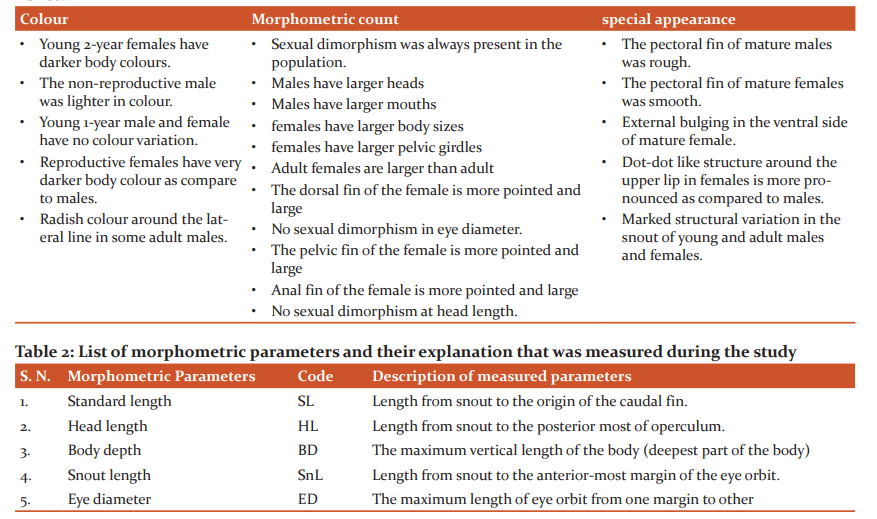
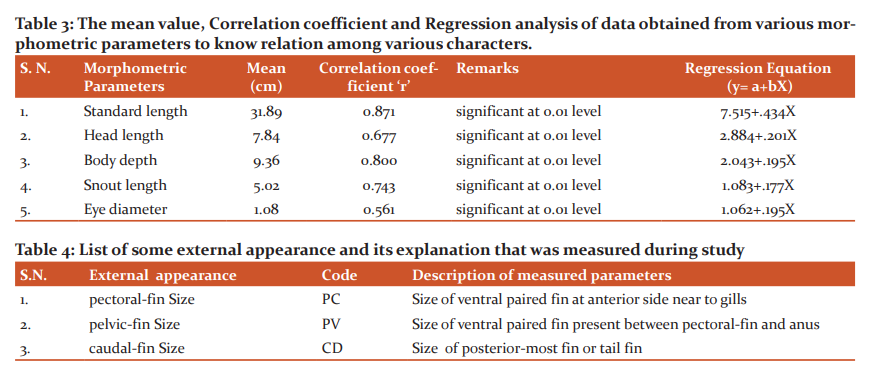
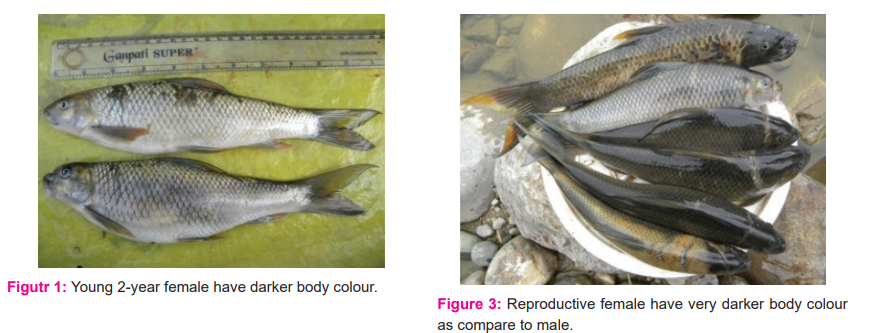
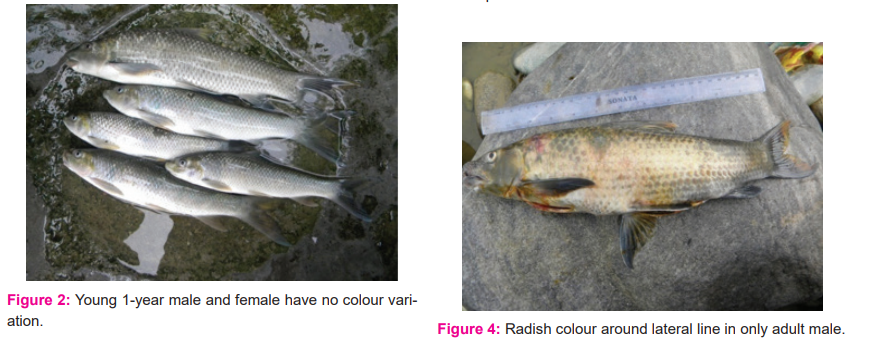
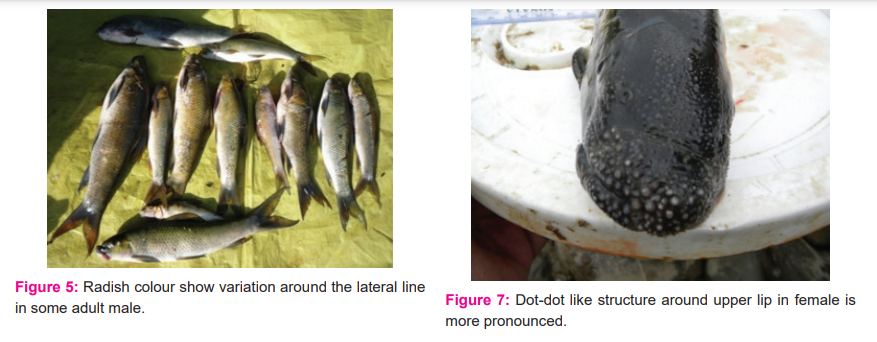
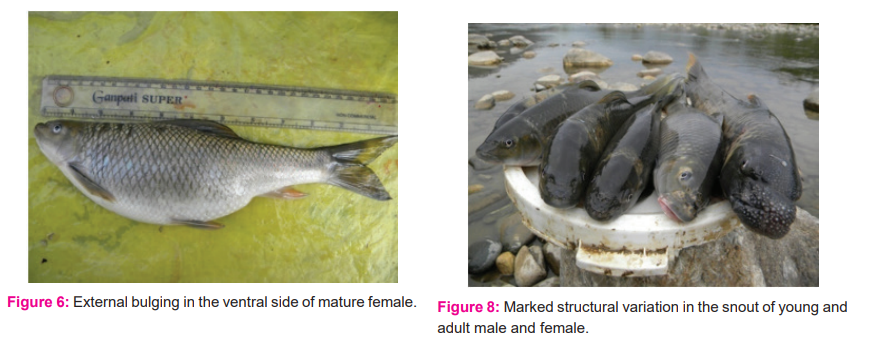
Discussion
In our study male and female fish show sexual dimorphism, Labeo dyocheilus show clear sexual dimorphism as in fishes it was extremely normal 16, 17. In animals, sexual dimorphism occurs generally based on size and appearance 18 likewise during the investigation of sexual dimorphism we saw variety in different body structures and body shape and colour in Labeo dyocheilus. In our investigation changes in shading of fishes were seen at various periods of life history though numerous specialists have detailed that morphological sexual dimorphism in fish goes from changes in body colouration 10.
Fishes additionally show variety in their different fins that was dorsal, pectoral, pelvic and anal fins. This finding was similar to the result observed by Conway and Britz 19 who depicted outrageous osteological sexual dimorphism of the pivotal skeleton. Anal fin of fish Puntius binotatus was recorded and which was also showing variations 20. Variety in different fins in male and female was additionally referenced in literature by different scientific workers. This point is coordinate with Park et al., 10 discoveries about the rapid growth in the first and second spines of the dorsal fin at the degree of various sexes.
Different extraordinary characters were likewise reported during the clarification of sexual dimorphism in Labeo dyocheilus, correspondingly development of tubercles on the fins during reproducing season 2. We noticed male and female fish of Labeo dyocheilus having different morphological varieties, however restraining or having a similar ecological niche. Sexual dimorphism could likewise be a practical change for various propensities for the genders 11, 21. Labeo dyocheilus show sexual dimorphism during breeding season likewise comparative report additionally distributed by another researcher who told that effect of physio-chemical factor and sexual dimorphism is the conceptive necessities of the adults 7, 22.
Reproductively mature female fish show external bulging in ventral side only during the breeding season, it was also expected that the body shape of a fish matures especially the shape of the abdomen as reproductive structures develop in the fish body 7. Young males and females showed no colour variation, reproductive mature darker colour, and radish colour in male were reported in our study, this study was mainly supported by various previous literature 6, 13.
Conclusions
In this piece of composing, we are going towards the conclusion of the finding regarding the aim and objectives. Labeo dyocheilus show sexual dimorphism at different levels so this information would be helpful to receive better arrangement for its mono-sex culture by the mature fish identification. Information on a different part of sexual dimorphism was useful to decide the eco-behaviour of the fish all through life history. This examination satisfies the gap concerning writing in the particular zone.
Acknowledgement
The author is thankful to his research scholars for giving their precious time for helping during the writing and formatting of this work.
Conflict of Interest
The author is grateful to the Department of Zoology of LSM Government Post Graduate College Pithoragarh for giving the laboratory, technical and specialized help during the exploration.
Funding Information
The author is grateful to the L.S.R.B. – D.R.D.O. (R & D), New Delhi organization for technical and financial support under the major project, during our research work.
Author’s Contribution
The author confirms sole responsibility for the following; study conception, design, data collection, analysis, interpretation of results, writing, formatting, plagiarism removal and final drafting of manuscript preparation.
References:
-
Verma R. Seasonal changes in the histological profile of the testicular and ovarian cycle of Labeo dyocheilus. Int J Fish Aqua Sci. 2013;3(2):143-9.
-
Jyoti MK, Sharma A. Fishes, aid to collection preservation and identification. Daya Publishing House 2006.
-
Darwin C. The descent of man and selection about sex. D. Appleton 1896.
-
Andersson M. Sexual selection. Princeton University Press 1994 Jun 16.
-
Blanckenhorn WU. Behavioural causes and consequences of sexual size dimorphism. Ethology. 2005 Nov;111(11):977-1016.
-
Kitano J, Mori S, Peichel CL. Sexual dimorphism in the external morphology of the threespine stickleback (Gasterosteus aculeatus). Copeia. 2007 May;(2):336-49.
-
Hassell EM, Meyers PJ, Billman EJ, Rasmussen JE, Belk MC. Ontogeny and sex alter the effect of predation on body shape in a livebearing fish: sexual dimorphism, parallelism, and costs of reproduction. Eco & Evo. 2012 Jul; 2(7):1738-46.
-
Zelditch M, Swiderski D, Sheets DH, Fink W. Geometric morphometrics for biologists. Elsevier: Acad. Press 2012;416 p.
-
Walker JA. Ecological morphology of lacustrine three spine stickleback Gasterosteus aculeatus L. (Gasterosteidae) body shape. Biol J Linn Soci. 1997 May 1;61(1):3-50.
-
Park IS, Zhang CI, Lee YD. Sexual dimorphism in morphometric characteristics of cocktail wrasse. J Fish Biol. 2001 Jun; 58(6):1746-9.
-
Burns JG, Di Nardo P, Rodd FH. The role of predation in variation in body shape in guppies Poecilia reticulata: a comparison of field and common garden phenotypes. J Fish boil. 2009 Oct; 75(6):1144-57.
-
Echeverria TW. Sexual dimorphism in four species of rockfish genus Sebastes (Scorpaenidae). Env Biol Fish. 1986 Mar; 15(3):181-90.
-
Webster MA, Sheets HD. A practical introduction to landmark-based geometric morphometrics. Quant met Paleobiol. 2010 Oct 30;16:168-88.
-
Blanckenhorn WU. Behavioural causes and consequences of sexual size dimorphism. Ethol. 2005 Nov; 111(11):977-1016.
-
Lowe McConnel RH. Identification of Freshwater fishes. Black well Scientific Publication. Edinburg, Oxford 1971.
-
McGrath PE, Hilton EJ. Sexual dimorphism in longnose gar Lepisosteus osseus. Journal of Fish Biology 2012 Feb;80(2):335-45.
-
McDonald DL, Anderson JD, Hurley C, Bumguardner BW, Robertson CR. Sexual dimorphism in alligator gar. N Am J Fish Manag. 2013 Aug 1;33(4):811-6.
-
Hedrick AV, Temeles EJ. The evolution of sexual dimorphism in animals: hypotheses and tests. Trn Eco Evo. 1989 May 1;4(5):136-8.
-
Conway KW, Britz R. Sexual dimorphism of the Weberian apparatus and pectoral girdle in Sundadanio axelrodi (Ostariophysi: Cyprinidae). J Fish Biol. 2007 Nov;71(5):1562-70.
-
Dorado EL, Torres MA, Demayo CG. Sexual dimorphism in body shapes of the spotted barb fish, Puntius binotatus of Lake Buluan in Mindanao, Philippines. Aqua, Aqua, Cons Legl. 2012 Dec 1;5(5):321-9.
-
Spoljaric MA, Reimchen TE. Habitat-dependent reduction of sexual dimorphism in geometric body shape of Haida Gwaii threespine stickleback. Biol J Linn Soci. 2008 Nov 1;95(3):505-16.
-
Rakesh V. Current status of Physico-chemical characteristics and biological factor of W. Ramganga River in Kumaun Himalaya, India. Int J Cur Microbiol App Sci. 2013;2(8):114-23.
|






 This work is licensed under a Creative Commons Attribution-NonCommercial 4.0 International License
This work is licensed under a Creative Commons Attribution-NonCommercial 4.0 International License